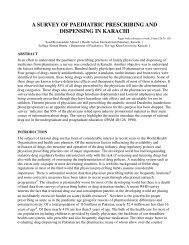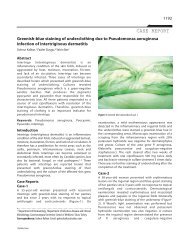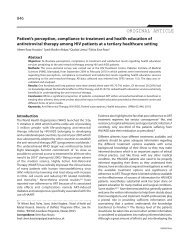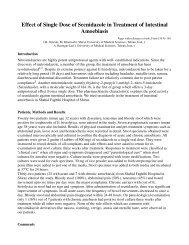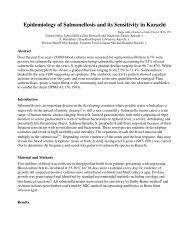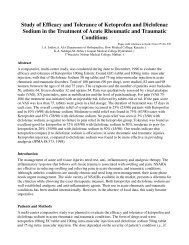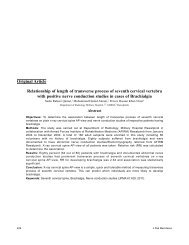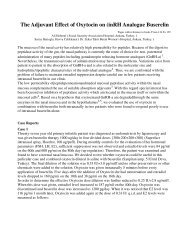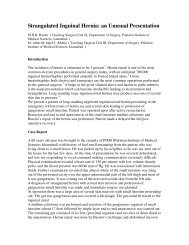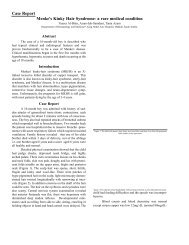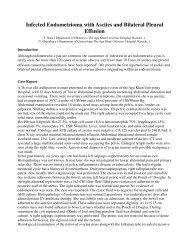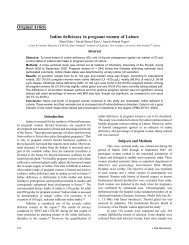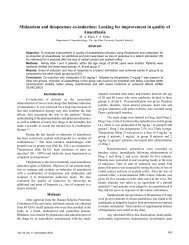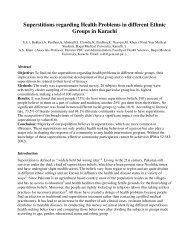Cutaneous Leishmaniasis : Iso-enzyme characterisation of ...
Cutaneous Leishmaniasis : Iso-enzyme characterisation of ...
Cutaneous Leishmaniasis : Iso-enzyme characterisation of ...
You also want an ePaper? Increase the reach of your titles
YUMPU automatically turns print PDFs into web optimized ePapers that Google loves.
Areas 26,27 (N.A.). Azad Janunu and Kashmi? (AJK) and Baluchistan 29,30 ~ L. infantum has been<br />
identified as the causative organism <strong>of</strong> this disease, in patients from AJK and N.A. 31,32 . The same<br />
parasite has also been identified in isolates obtained from domestic dogs from AJK and N.A. 33 . Two<br />
types <strong>of</strong> CL, zoonotic CL and anthroponotic CL are endemic in different parts <strong>of</strong> the country 34 and the<br />
classification <strong>of</strong> CL in Pakistan has been based mainly upon the clinical features, epidemiology and<br />
sandfly fauna 34-36 . The identity <strong>of</strong> parasites causing CL in Pakistan has notyet been ascertained and this<br />
is the first report describing the isolation and <strong>characterisation</strong> <strong>of</strong> Leish.mania parasites from patients<br />
with cutaneous disease.<br />
Materials and Methods<br />
<strong>Iso</strong>lation <strong>of</strong> Leishmania parasites from CL patients<br />
Patients with suspected cutaneous leishmaniasis were referred to the National Institute <strong>of</strong> Health (NIH),<br />
from different hospitals in Islamabad for parasitological diagnosis, isolation and culture <strong>of</strong> the<br />
parasites. Samples were obtained from the indurated ulcer margins using a small serrated dental probe<br />
and inoculated in the bi-phasic NNN medium was also sent to Multan where aspiration/biopsy material<br />
from the lesions was inoculated into the medium and dispatched by couricr service to NIH in<br />
Islamabad, where the inoculates were maintained initially at NIH, Islamabad, until their shipment to the<br />
London School <strong>of</strong> Hygiene and Tropical Medicine, where they were frozen and stores in liquid nitrogen<br />
until further use.<br />
<strong>Iso</strong>enzy me characterization<br />
Princciples <strong>of</strong> enzy me electrophoresis: Soluble <strong>enzyme</strong>s are extracted fron the parasite and are placed<br />
in a gel matrix containing a buffer, the pH <strong>of</strong> which is pre-selected to render the iso<strong>enzyme</strong>s a negative<br />
charge. When a direct current is passed through the gel, the iso-<strong>enzyme</strong>s migrate through the matrix<br />
according-to their overall or net charge. As the net charges may be quantitatively different, iso<strong>enzyme</strong>s<br />
with the greatest negative charge move the farthest towards the anode, while those with the least<br />
negative charge travel the shortest. The bands <strong>of</strong> iso<strong>enzyme</strong>s are then visualized by appmpriate staining<br />
techniques.<br />
Preparation <strong>of</strong> samples<br />
The isolates stored in liquid nitregen were taken out, quickly, thawed quickly and inoculated in biphasic<br />
NNN medium37. In most cases the cultures grew well, however, in cases where the parasite<br />
revival was slow, inoculation in Sloppy Evans medium 37 was carried out. As soon as the organisms<br />
began to thrive and multiply rapidly in the initial agar medium, they were transferred to liquid medium<br />
(MEM:EBLB:FCS 37 ) for mass culture. In cases where growth was slow, the MEM:FEBLB:FCS<br />
medium was supplemented by the addition <strong>of</strong> 1% human urine obtained from a healthy individual and<br />
filtered through a 0.2 um Milipore filter (Sartonus AG) This greatly enhanced the growth <strong>of</strong> the<br />
promastigotes 38 . Log phase promastigotes (1x10 7) were harvested and washed 2x in PBSS (Proline<br />
Balance Salt Solution). The pallet was mixed with an equal amount <strong>of</strong> <strong>enzyme</strong> stabiiser (a mixture<br />
containing 2 mM each <strong>of</strong> Ethylene diamine tetra acetic acid, E- aminocaproic acid and Dithiothreitol).<br />
The final mixture was snap frozen and thawed 3x in liquid nitrogen and centrifuged at 10,000 0 for half<br />
an hour. The pallet was discarded and the supematant was stored as 15 uL beads (lysate) in liquid<br />
nitrogen until use.<br />
Starch Gel Electrophoresis<br />
Thin layer starch gel electrophoresis was carried out according to the previously described technique39.<br />
The gels were prepared using hydrolysed potato starch (Connaught Laboratories Limited), 7.5 gm/l00<br />
ml, in appropriate in gel (tank) buffer solutions. Linear slots were made in a straight line at regular<br />
intervals across the gel and samples applied using cotton thread (Anchor stranded embroideiy cotton)



